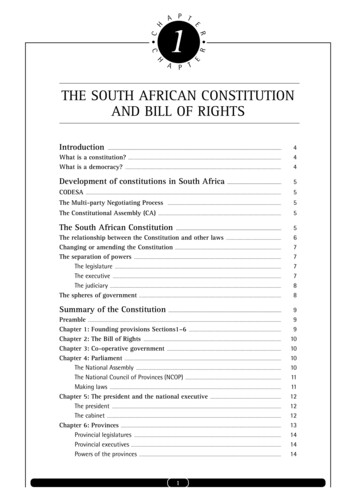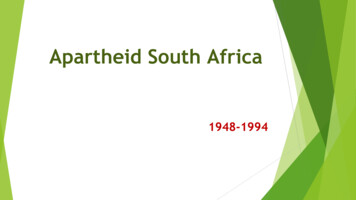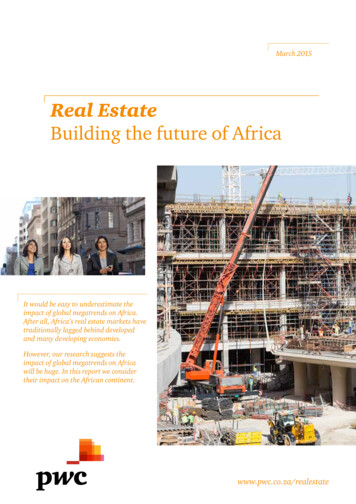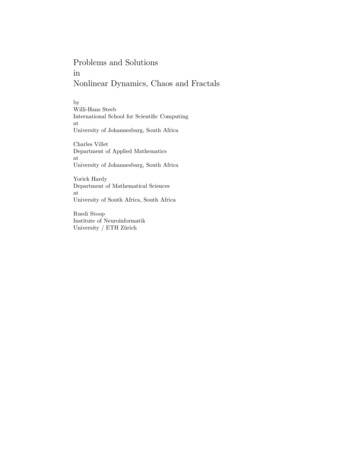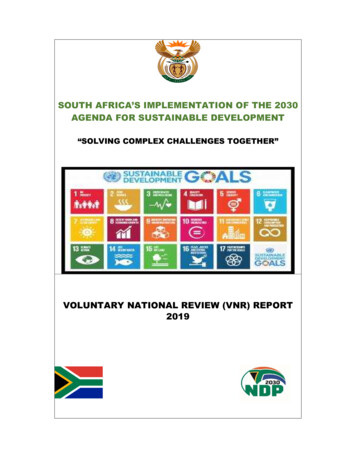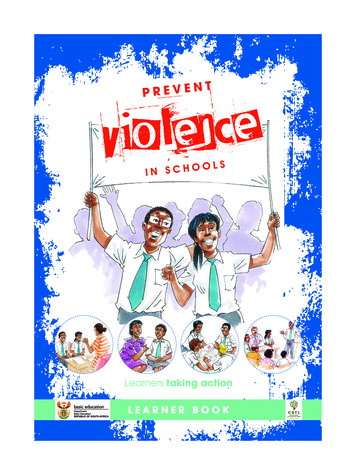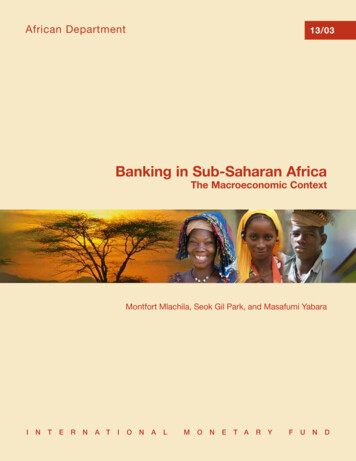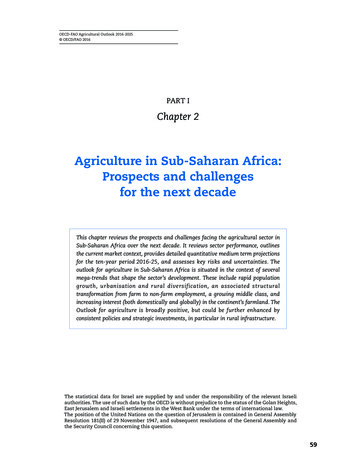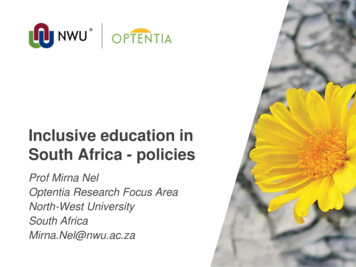
Transcription
Inclusive education inSouth Africa - policiesProf Mirna NelOptentia Research Focus AreaNorth-West UniversitySouth AfricaMirna.Nel@nwu.ac.za
Outcomes Understanding andcontextualizing inclusiveeducation policies in South Africa2
Inclusion within an African perspective Saying in Sepedi: a person is a person because thatperson exists among others, not in isolation (Mahlo,2017). It takes a village to raise a child.– Whole school community, parents, elders, wider families and cultural custodians– Togetherness,– sharing and reciprocity– acknowledgement of every child’s identity, history, culturesand experiences that they bring to school (Phasha, Mahlo& Dei, 2017; Mahlo, 2017).3
South African classrooms4
South Africa background Video – education in South Africa https://www.youtube.com/watch?v nPeJXG6GqPE Classrooms ligion,language - 11 official languagesabilities. This in itself represents inclusivity. The focus of inclusive education in South African– Not only be disability-centred,– Broader purpose of social inclusion and addressing diverse learningneeds.5
South Africa background Poor human rights history Discriminatory policies and practices segregated learners based onrace and disability. Special schools mostly accommodated white learners and werewell-resourced. Few under-resourced special schools for black learners withdisabilities - included by default into mainstream education. Access to special schools - a battery of tests by different healthprofessionals (e.g. doctors, psychologists, speech-and-oroccupational therapists or social workers) Only learners with organic or medical disabilities and severebehaviour problems - attend special schools. Nearly 240 000 learners with disabilities were out of school (DoE,2001).6
South Africa laws and policies South African Constitution (1996)South African Schools Act (1996)National Education Policy Act (NEPA) of 1996Integrated National Disability Strategy (INDS) (1997)White Paper on the Rights of Persons with Disabilities (WPRPD)(2015)National development plan (NDP) 2030 (2011)National Commission on Special Needs in Education and Training(NCSNET) and the National Committee for Education SupportServices (NCESS) report (1997)Education White Paper 6 (EWP6) (2001)Admission of learners to public schools (2001)Department of Education (DoE). Draft conceptual and operationalguidelines for the implementation of inclusive education. (2002)7
South Africa laws and policies Department of Education. Conceptual and operational guidelines forspecial schools as resource centres. (2005) Department of Education. Conceptual and operational guidelines fordistrict based support teams. (2005) Department of Education. Guidelines for inclusive learningprogrammes. (2005) Guidelines to Ensure Quality Education and Support in SpecialSchools and Special School Resource Centres (Department ofEducation, November 2007) National Minimum Norms and Standards For School Infrastructure(2009) Department of Basic Education (DBE). Guidelines for fullservice/inclusive schools (2010) Guidelines for Inclusive Teaching and Learning (Department ofBasic Education, 2010)8
South Africa laws and policies Guidelines for responding to learner diversity in theclassroom through curriculum and assessment policystatements (Department of Basic Education, 2011) Policy on Screening, Identification, Assessment andSupport (SIAS) (2014) General legislation –– Promotion of Equality and Prevention of UnfairDiscrimination Act 2000– Children’s Act 2005– Mental health care act 2002– Criminal Law (sexual offenses) Act 2007– National youth development agency act 20089
Constitution Constitution (1996:6), article 9 (3) that no unfairdiscrimination “directly or indirectly againstanyone on one or more grounds, including race,gender, sex, pregnancy, marital status, ethnic orsocial origin, colour, sexual orientation, age,disability, religion, conscience, belief, culture,language and birth” will be tolerated. Article 10 “Everyone has inherent dignity andthe right to have their dignity respected andprotected” (1996:6). The right to basic education for everyone article 29 (1).10
South African Schools Act and National EducationPolicy Act The South African Schools Act (SASA) (1996)– no person may unfairly discriminate against a learner and that alllearners shall enjoy equal treatment before the law and shallreceive equal protection and benefits of the law. National Education Policy Act (NEPA) of 1996, article 4 (d)– no person may be denied the opportunity to receive aneducation to the maximum of his or her ability as a result of aphysical disability.– every person must be protected against unfair discriminationwithin or by an education department or institution on anygrounds and that the right to basic education and equal accessto education institutions are guaranteed (National EducationPolicy Act of 1996)11
White Paper on an Integrated National DisabilityStrategy and White Paper on the Rights ofPersons with Disabilities 1997 - White Paper on an Integrated National Disability Strategy(INDS)– people with disabilities are excluded from mainstream societyand consequently experience difficulty in accessing fundamentalrights.– Vision of the INDS was to integrate disability issues in allgovernment development strategies, planning and programmes,as well as capacity building and wide public education on theseissues (INDS, 1997). 2015 - White Paper on the Rights of Persons with Disabilities(WPRPD).– Accelerate transformation and redress with regard to fullinclusion, integration and equality for persons with disabilities.– UN Convention on the Rights of Persons with Disabilities(UNPRD) is embedded in this white paper12
National Development Plan 2030 National Development Plan (NDP) 2030 (South Africa, 2011)– disability often leads to poverty and– people with disabilities face multiple discriminatory barriers.– quality education and equal employment opportunities should be apriority.– “inclusive education should be provided that enables everyone toparticipate effectively in a free society. Education provides knowledgeand skills that people with disabilities can use to exercise a range ofother human rights, such as the right to political participation, the right towork, the right to live independently and contribute to the community,the right to participate in cultural life, and the right to raise a family.Ensuring that all children with disabilities have access to qualityeducation will help South Africa meet its employment equity goals in thelong run (NDP, 2011: 304)13
National Commission on Special Needs in Education andTraining (NCSNET) and the National Committee forEducation Support Services (NCESS) - 1997 In 1996 - National Commission on Special Needs in Education andTraining (NCSNET) and the National Committee for EducationSupport Services (NCESS) Findings (i) small percentage of learners with disabilities within ‘special’schools and classes; (ii) on a racial basis; (iii) fallen outside of the system or been ‘mainstreamed by default’;(iv) failed to respond to the diverse needs of the learner population, massive numbers of drop-outs, push-outs, and failures (v) learning needs are not appropriately considered and are in manyinstances seen as “ineducable”, particular those with mentaldisabilities14
National Commission on Special Needs in Education andTraining (NCSNET) and the National Committee forEducation Support Services (NCESS) - 1997 Recommendationstransforming all aspects of the education systemintegrated system of educationinfusing ‘special needs and support services’barrier-free physical environment and a supportive and inclusivepsycho-social learning environmentdeveloping a flexible curriculum to ensure access to all learnerspromoting the rights and responsibilities of parents, educators andlearnersproviding effective development programmesfostering holistic and integrated support provision throughintersectoral collaborationdeveloping a community-based support systemfunding strategies that ensure redress and access15
South Africa Education White Paper 6 (EWP6) Education White Paper 6 Principles prominent in inclusive education – for alllearners:– human rights– social justice for all learners;– participation– social integration;– equal access to a single, inclusive education system;– access to one curriculum;– equity and redress; and– community responsiveness16
South Africa EWP6 Education White Paper 6 definition of inclusive education– Is about acknowledging that all children and youth can learn and that all––––––children and youth need supportIs accepting and respecting the fact that all learners are different insome way and have different learning needs which are equally valuedand an ordinary part of our human experienceIs about enabling education structures, systems and learningmethodologies to meet the needs of all learnersAcknowledges and respects difference in children, whether due to age,gender, ethnicity, language, class, disability, HIV status, etc.Is broader than formal schooling, and acknowledges that learningoccurs in the home, the community, and within formal and informalmodes and structuresIs about changing attitudes, behaviours, methodologies, curricula andenvironments to meet the needs of all childrenIs about maximising the participation of all learners in the culture andthe curriculum of educational institutions and uncovering and minimisingbarriers to learning17
Terminology History of discriminatory and exclusionary practices words/terminology can have a significant impact. Harm, label and stereotype or carry over a message of inclusion and belonging. Special educational needs (SEN), disabilities andimpairments - label and categorise learners. Categorised according to the disability/impairment Separated from mainstream education and placed inspecial education settings. Believe that these learners will not be able to achievesuccess in a mainstream academic and working worldsince these disabilities are judged as arising from withinthe learner18
Barriers to learning Learners experiencing barriers to learning and development– anything that stands in the way of a child being able to learn. Extrinsic barriers to leaning and development are circumstancesoutside of the learner that result in learning difficulties.– caused by the societies in which learners live or by the school systemitself.– socioeconomic barriers– poverty;– a dysfunctional family;– abuse,– crime,– gangs,– violence– lack of basic amenities such as water, electricity, proper housing, andablution facilities;– gender issues in cultural groups and in society as a whole; and– a home language that differs from the language of learning and19teaching.
Barriers to learning Within the school system–––––––––lack of basic and appropriate learning support materials;inadequate facilities at schools;overcrowded classrooms; anda dysfunctional management system.poor teaching and/orteachers that are not properly trained;insufficient support from teachers;inappropriate and unfair assessment practices;an inflexible curriculum (e.g. not relevant to learners’ pace, priorknowledge, learning styles);– teachers not being able to deal with a diversity of learning needs;– poor classroom management20
Barriers to learning Intrinsic barriers to learning and development correspond toconditions within the learner.– medical conditions and disabilities. genetic, neurological, occur as a consequence of pregnancy or birthcomplications or they could be the result of accidents or illnesses. cognitive disabilities, sensory impairments such as visual and hearing impairments, physical impairments (e.g cerebral palsy), and neurological conditions (e.g. epilepsy or dyslexia) EWP6 (DoE, 2001) recognises that the terms SEN, disability andimpairments are still internationally used SEN and LSEN continuous to be used in colloquial educationalconversations Still classified as LSEN
Support structures Mainstream schools Full-Service Schools (Inclusive schools) Special Schools as resource centres– Now 500 000 learners on waiting listsfor special classes/schools District Based Support Teams (DBST) School Based Support Teams (SBST) Policy on Screening, Identification,Assessment and Support (SIAS) – 201422
Report on the Implementation of Education WhitePaper 6 on Inclusive Education - 2015 Incoherent conception and understanding Inclusive Education andTraining System Disparities across provinces in resourcing and improving access toeducation and support for children with disabilities– Support staff– Buildings Limited access to specialist support services particularly in publicordinary schools resulting in too many learners referred out (pushedout) to special schools or remaining in mainstream schools withoutany appropriate support. Large number of drop out of the system before they completeschooling; Early intervention including remediation (direct correlation betweenavailability of support services and results in districts);23
Report on the Implementation of Education WhitePaper 6 on Inclusive Education - 2015 Special schools do not have adequate specialist professionalsupport staff and non‐teaching staff; No structured stakeholder engagement and partnerships to advancethe course of inclusion General Household Survey of 2013– 25.9% children with disabilities in the 5 to 15 year old group who are notattending and education institution. 2011 national census– 5.8% of children between the ages of 5 and 18 are disabled.– Could imply that more than 500 000 children with disabilities may in factbe out of school24
25
26
27
28
Policy on Screening, Identification, Assessmentand Support (SIAS) – 2014 SIAS A “framework for the standardisation of the procedures to identify,assess and provide programmes for all learners who requireadditional support to enhance their participation and inclusion inschool” (DBE, 2014:1). A central aim of the SIAS policy is– to improve access to quality education for– vulnerable learners and those who experience barriers tolearning– in ordinary and special schools– learning difficulties due to barriers such as family disruption,language issues, poverty, disability, etc. (DBE, 2014).29
Challenges in implementing inclusiveeducation Good policies Including learners with disabilities in amainstream classroom are seen by many peoplein the South African society as still challengingand only an ideology. Bornman and Rose (2010, p. 7) : “[a] generallack of support and resources, as well as theprevailing negative attitudes toward disability, allcontribute to the general bewilderment in SouthAfrican schools towards inclusion”.30
Challenges in implementing inclusiveeducation Negative attitudes of society (including teachers) Large class sizes Learning needs that are too diverse in one class (e.g. differentabilities, disabilities, languages, cultures, religions, socio-economiccircumstances, etc.) Poor language proficiency in the Language of Learning andTeaching (LOLT) as a consequence of learners not learning in theirmother tongue Poor socioeconomic circumstances of learners, resulting in socialproblems and inadequate resources Too many problematic home circumstances as a result of poverty,social problems, illnesses (such as HIV and AIDS and tuberculosis)and other reasons31
Challenges in implementing inclusiveeducation Poor parental support Inappropriate and/or insufficient resources and learning materials,especially for learners with disabilities (such as Braille material forthe visually impaired, hearing aids for learners with hearingimpairments and mobility support for the physically disabled) Inadequate training of teachers who need to deal with diverselearning needs and barriers to learning Restricted financial resources Limited and poor functioning support structures Continuous curriculum changes Too many administrative duties for teachers Discipline and behaviour problems in classes32
Challenges in implementing inclusiveeducation Report on the Implementation of Education White Paper 6 onInclusive Education (DBE, 2015) Large increase of learners with disabilities enrolling in schools it isestimated– Still more than 500 000 children with disabilities between 5 and 18 yearsold out of school, which are more than double the number that wasinitially identified in 2001. Reasons for this– Limited resources with regard to personnel provisioning (support staffand teachers) and– finance,– inadequate access to specialist support services,– insufficient processes and procedures to identify children withdisabilities early and– a large number of drop-outs before these learners complete schooling(DBE, 2015; Mutukrishna et al. 2016).33
Good practice Teachers believe inclusiveeducation is the “right thingto do” Human Rights https://www.youtube.com/watch?v 828QHy53JFQ Inclusive education in SA - video34
Dank je welThank youDankieKea le Boha35
Resources Report on the Implementation of Education White Paper 6 onInclusive Education 2015 m/160308overview.pdf http://www.optentia.co.za/symposium.php?id Mg%3D%3D http://www.optentia.co.za/symposium.php?id Nw%3D%3D Berger, M. (2013). The role of the educational psychologist insupporting inclusion at school level. M Ed dissertation. University ofPretoria (Unpublished). Bornman, J. & Donohue, D. K. (2013). South African teachers’attitudes toward learners with barriers to learning: Attention-deficitand hyperactivity disorder and little or no functional speech.International Journal of Disability, Development and Education60(2), 85-104.36
Resources Bornman, J. & Rose, J. (2010). Believe that all can achieve:Increasing classroom participation in learners with special supportneeds. Pretoria: Van Schaik. Chataika, T., Mckenzie, J. A., Swart, E. & Lyner-Cleophas, M.(2012). Access to education in Africa: Responding to the UnitedNations Convention on the Rights of Persons with Disabilities.Disability & Society. 27(3), 385–398 Department of Basic Education. (DBE) (2014). Policy on Screening,Identification, Assessment and Support (SIAS), Pretoria: Sol PlaatjieHouse. Department of Basic Education. (2015). White Paper 6 on inclusiveeducation an overview for the period: 2013 ‐ 2015. Pretoria: Sol37
Resources Plaatjie House. Department of Education. (1997). Quality education for all.Overcoming barriers to learning and development. Report of theNational Commission on Special Needs in Education and Training(NCSNET) National Committee on Education Support Services(NCESS). Government printer: Pretoria. Department of Education (DoE). (2001). Education White Paper 6:Special Needs Education. Building an inclusive education andtraining system. Pretoria: Department of Education. Engelbrecht, p. Nel, M., Smit, S. & Van Deventer, M. (2016). Theidealism of education policies and the realities in schools: theimplementation of inclusive education in South Africa. InternationalJournal of Inclusive Education, 20(5), 520-535 Mahlo, D. 2017. Rethinking inclusive education in an Africancontext. In Phasha, N., Mahlo, D. & Dei, G. J. S (Eds.), Inclusiveeducation in African contexts (pp. 1-17). Rotterdam: SensePublishers.38
Resources Makhalemele, T. & Nel. M. (2016). Challenges experienced bydistrict-based support teams in the execution of their functions in aspecific South African province. International Journal of InclusiveEducation, 20(2), 168-184. Muthukrishna, N., Morojele, P., Naidoo, J. & D’Amant, A. (2016).Access to education: experiences from South Africa. In G.E. Iriarte,R. McConkey & R. Gilligan (Eds), Disability and human rights:Global perspectives, (pp. 133-149). London: Palgrave. Nel, M. (2013). Understanding inclusion. In Engelbrecht, A.,Swanepoel, H., Nel, M. & Hugo, A. (Eds.), Embracing diversitythrough multilevel teaching. (pp. 1-32). Cape Town: JUTA. Nel, M., Engelbrecht, P., Nel, N.M. & Tlale, D. (2014). South Africanteachers’ views of collaboration within an inclusive educationsystem. International Journal of Inclusive Education, 18(9), 903–917.39
Resources Nel, M., Nel, N.M. & Hugo, N. (2016). Inclusive education: Anintroduction. In Nel, M., Nel, N.M. & Hugo, N. (Eds.), LearnerSupport in a Diverse Classroom. (2nd ed). (pp. 3-34). Pretoria: VanSchaik. Nel, N.M., Tlale, L.D.N, Engelbrecht, P & Nel, M, (2016). Teachers'perceptions of education support structures in the implementation ofinclusive education in South Africa. KOERS — Bulletin for ChristianScholarship, 81(3). https://doi.org/10.19108/ KOERS.81.3.2249 Oswald, M. & Swart, E. (2011). Addressing South African preservice teachers’ sentiments, attitudes and concerns regardinginclusive education. International Journal of Disability, Developmentand Education, 58(4), 389–403. Phasha, N., Mahlo, D. & Dei, G. J. S. (2017). Inclusive schoolingand education in African contexts. In Phasha, N., Mahlo, D. & Dei,G. J. S (Eds.), Inclusive education in African contexts (pp. 1-17).Rotterdam: Sense Publishers40
Resources Republic of South Africa (RSA). (1996a). Constitution (Act 108 of1996). Pretoria: Government Printer Republic of South Africa (1996b). South African Schools Act 84 of1996. Pretoria: Government Printer. Sayed, Y & Ahmed, R. (2015). Education quality, and teaching andlearning in the post-2015 education agenda. International Journal ofEducational Development, 40, 330–338. Swart, E. & Pettipher, R. (2016). A framework for understandinginclusion. In E. Landsberg, D. Kruger & E. Swart (Eds.), Addressingbarriers to learning. A South African perspective. (pp. 3–23).Pretoria: Van Schaik Walton, E. (2015). Global concerns and local realities: The “MakingEducation Inclusive” Conference in Johannesburg. Intervention inSchool and Clinic, 50(3), 173–177. Wildeman, R. A., & Nomdo, C. (2007). Implementation of inclusiveeducation: How far are we? IDASA Inclusive education OccasionalPapers. Retrieved from http://www.idasa.org.za41
Only learners with organic or medical disabilities and severe behaviour problems - attend special schools. Nearly 240 000 learners with disabilities were out of school (DoE, 2001). 6 South Africa background South African Constitution (1996) South African Schools Act (1996)


